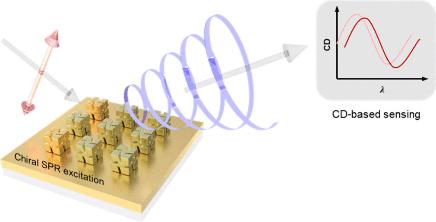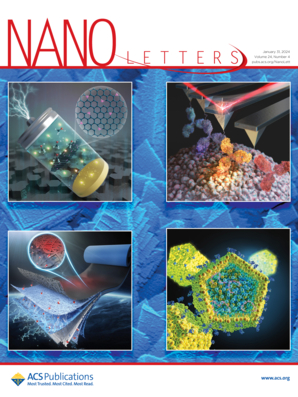Helicoid Grating-Coupled Surface Plasmon Resonance Sensor
IF 9.6
1区 材料科学
Q1 CHEMISTRY, MULTIDISCIPLINARY
引用次数: 0
Abstract
Ultrasensitive, rapid, and reliable biomolecular sensing is essential for biomedical diagnostics, requiring real-time monitoring and detection of trace samples. Optical sensing, particularly plasmonic biosensing, meets these demands through noninvasive, high-sensitivity detection based on the interaction between light and molecules. Here, we present novel plasmonic metamaterial-based sensing strategy, utilizing the circular dichroism (CD) response of grating-coupled surface plasmon resonance (SPR) from chiral nanoparticle grating structure (i.e., 2D helicoid crystal) on gold substrate. Strong chiroptic response of helicoids has been effectively expanded to produce a remarkable CD/greflection response in the SPR mode, achieved by spectral coupling of SPR with localized surface plasmon resonance (LSPR) in helicoids. This CD response, derived from the differential of left and right circularly polarized light, corrects optical fluctuations, enhancing sensitivity and reliability. Our SPR-CD-based approach achieves a sensitivity of 379.2 nm/RIU and detection limit of a few mM for d-glucose, offering a new paradigm for high-performance optical biosensors.

螺旋光栅耦合表面等离子体共振传感器
超灵敏、快速和可靠的生物分子传感对生物医学诊断至关重要,需要对痕量样本进行实时监测和检测。光学传感,尤其是质子生物传感,通过基于光与分子之间相互作用的非侵入式高灵敏度检测满足了这些需求。在此,我们提出了基于质子超材料的新型传感策略,利用金基底上的手性纳米粒子光栅结构(即二维螺旋状晶体)产生的光栅耦合表面等离子体共振的圆二色性(CD)响应。通过 SPR 与螺旋状晶体中局部表面等离子体共振 (LSPR) 的光谱耦合,螺旋状晶体的强自旋响应得到了有效扩展,从而在 SPR 模式下产生了显著的 CD/反射响应。这种 CD 响应源自左右圆偏振光的差分,可纠正光学波动,提高灵敏度和可靠性。我们基于 SPR-CD 的方法实现了 379.2 nm/RIU 的灵敏度和几毫微米的 d-glucose 检测限,为高性能光学生物传感器提供了新的范例。
本文章由计算机程序翻译,如有差异,请以英文原文为准。
求助全文
约1分钟内获得全文
求助全文
来源期刊

Nano Letters
工程技术-材料科学:综合
CiteScore
16.80
自引率
2.80%
发文量
1182
审稿时长
1.4 months
期刊介绍:
Nano Letters serves as a dynamic platform for promptly disseminating original results in fundamental, applied, and emerging research across all facets of nanoscience and nanotechnology. A pivotal criterion for inclusion within Nano Letters is the convergence of at least two different areas or disciplines, ensuring a rich interdisciplinary scope. The journal is dedicated to fostering exploration in diverse areas, including:
- Experimental and theoretical findings on physical, chemical, and biological phenomena at the nanoscale
- Synthesis, characterization, and processing of organic, inorganic, polymer, and hybrid nanomaterials through physical, chemical, and biological methodologies
- Modeling and simulation of synthetic, assembly, and interaction processes
- Realization of integrated nanostructures and nano-engineered devices exhibiting advanced performance
- Applications of nanoscale materials in living and environmental systems
Nano Letters is committed to advancing and showcasing groundbreaking research that intersects various domains, fostering innovation and collaboration in the ever-evolving field of nanoscience and nanotechnology.
 求助内容:
求助内容: 应助结果提醒方式:
应助结果提醒方式:


